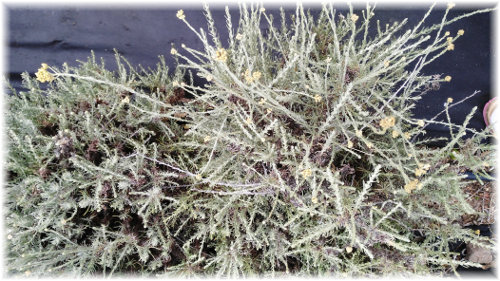


Helichrysum (Asteraceae family) Characteristics and uses:
Etymology: The name is derived from the Greek word "helisso", or "helios" (to turn around, or sun) and "chrysos" (golden), so the "sun gold" plant was named for its vibrant golden flower, but also because the ball-shaped blossom do not wither. Other uses: Helichrysum italicum (or angustifolium) produces, from its blossoms, a yellow-reddish essential oil , very popular, with a unique and intense fragrance and scent, which is used for medicinal purposes. It is anti-inflammatory, astringent, fungicidal, used also as a fixative in perfumes. Helicrysum tea is used for chloretic, diuretic, anti-inflammatory and anti-viral properties. Sometimes it is called the "curry plant" because of the strong smell of its leaves, but it has nothing whatsoever to do with this mixture of spices. It is also known as a cat deterrent (a "scaredy-cat" plant). History and folklore: It is considered as one of the oldest healing plants in Europe. Traditionally, herbalists have used the herb as a tincture or fluid extract for its anti-inflammatory, anti-oxidant and antibacterial properties (wounds, abrasions, scars, cuts). Pliny the Elder, the famous Roman naturalist, said the small golden flower was used for crowning the Gods. In the language of flowers helichrysum symbolizes eternal and endless love. ***** Erbe Matte cannot take any responsibility for any adverse effects from the use of plants. Always seek advice from a professional before using a plant medicinally***** **** We carefully dry helicrysum stems when they are crisp, at the first bloom; after they are dried out, we remove the leaves and flowers by sliding our fingers down each stem. **** Yes, you can use helichrysum in your kitchen. Leaves are used as a flavouring in salads, sweets, ice cream and soft drinks. In the vegan cuisine leaves and flowers are excellent to add flavor to vegetables, potatoes and in any dish with a fusion edge to it and in any recipe where you would use curries and spice mixes. Try to use it finely chopped to a chutney or in fritters. |
 This genus consist of an estimated 600 species, annuals or perennials; more than 20 of those species are native to the Mediterranean area, but it grows in Africa, Eurasia, Australasia and Madagascar. It is common on dry, rocky or sandy ground around the Mediterranean: it needs full sun. Helichrysum is grown as ornamental plants and for dried golden yellow flowers, blooming in summer, that preserve their colour and shape for long periods: for this reason it is known as an everlasting. Sometimes this plant is used as a spice: the young shoots and leaves are stewed in Mediterranean dishes (meat, fish or vegetable) to give their flavour, and removed before serving.
This genus consist of an estimated 600 species, annuals or perennials; more than 20 of those species are native to the Mediterranean area, but it grows in Africa, Eurasia, Australasia and Madagascar. It is common on dry, rocky or sandy ground around the Mediterranean: it needs full sun. Helichrysum is grown as ornamental plants and for dried golden yellow flowers, blooming in summer, that preserve their colour and shape for long periods: for this reason it is known as an everlasting. Sometimes this plant is used as a spice: the young shoots and leaves are stewed in Mediterranean dishes (meat, fish or vegetable) to give their flavour, and removed before serving. 